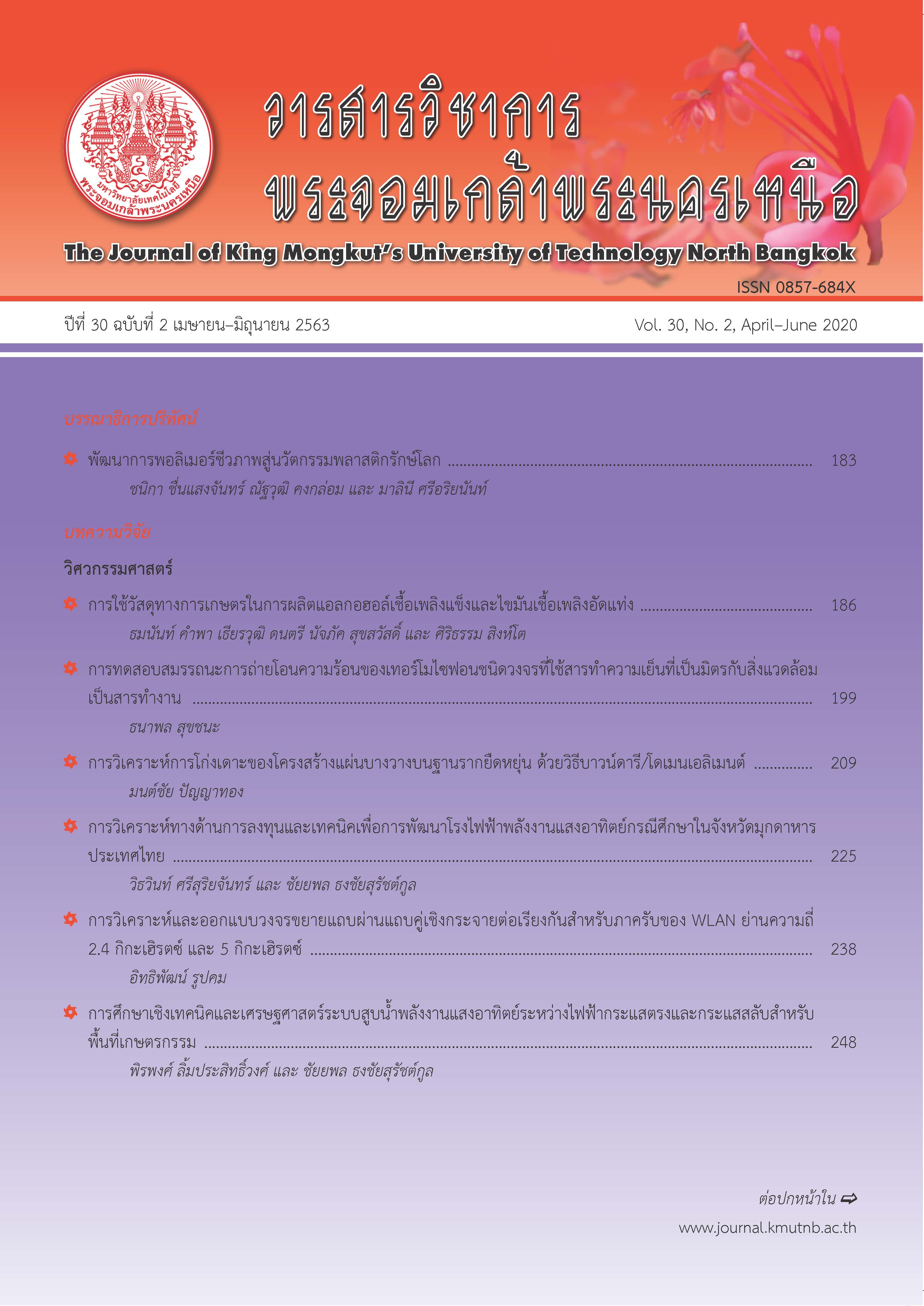การวิเคราะห์และออกแบบวงจรขยายแถบผ่านแถบคู่เชิงกระจายต่อเรียงกันสำหรับภาครับของ WLAN ย่านความถี่ 2.4 กิกะเฮิรตซ์ และ 5 กิกะเฮิรตซ์
Main Article Content
บทคัดย่อ
บทความนี้นำเสนอการวิเคราะห์และออกแบบวงจรขยายแถบผ่านแถบคู่เชิงกระจายต่อเรียงกันสำหรับภาครับของ WLAN ย่านความถี่ 2.4 กิกะเฮิรตซ์ และ 5 กิกะเฮิรตซ์ การวิเคราะห์ความถี่ของวงจรจะใช้เทคนิคการวิเคราะห์แบบโครงข่ายหลายความถี่เรโซแนนซ์ ซึ่งทำให้สามารถทำนายความถี่แถบผ่านทั้งสองแถบได้อย่างแม่นยำ การออกแบบวงจรและหาค่าอุปกรณ์สำหรับการจำลองจะเรียงลำดับตามขั้นตอนการออกแบบที่ได้อธิบายไว้ ผลการจำลองแสดงค่าอัตราขยายเท่ากับ 22.2 ดีบี แบนด์วิดท์เท่ากับ 0.495 กิกะเฮิรตซ์ ที่ความถี่ 2.4 กิกะเฮิรตซ์ และที่ความถี่ 5 กิกะเฮิรตซ์ มีอัตราขยายเท่ากับ 23.5 ดีบีแบนด์วิดท์เท่ากับ 0.65 กิกะเฮิรตซ์คิดเป็นค่า FBW เท่ากับ 20.6% และ 13% ตามลำดับ ค่ากำลังงานย้อนกลับจากเอาต์พุตสู่อินพุตน้อยกว่า –47 ดีบี และค่าจุดกด 1 ดีบี ด้านเอาต์พุตเท่ากับ –22 ดีบีเอ็ม และ –20.2 ดีบีเอ็ม ที่พอร์ตเอาต์พุต P2 และ P3 ตามลำดับ วงจรใช้ไฟเลี้ยงต่ำขนาด 1.5 โวลต์ กระแส 14 มิลลิแอมป์ การกำลังงานเท่ากับ 21 มิลลิวัตต์ จากผลการจำลองแสดงให้เห็นถึงความสอดคล้องกับการวิเคราะห์วงจรในทางทฤษฎีที่ได้สังเคราะห์ไว้
Article Details
บทความที่ลงตีพิมพ์เป็นข้อคิดเห็นของผู้เขียนเท่านั้น
ผู้เขียนจะต้องเป็นผู้รับผิดชอบต่อผลทางกฎหมายใดๆ ที่อาจเกิดขึ้นจากบทความนั้น
เอกสารอ้างอิง
[2] H. W. Wu, Y. F. Chen, and Y. W. Chen, “Multilayered dual-band bandpass filter using stubloaded stepped impedance and uniform impedance resonators,” IEEE Microwave and Wireless Components Letters, vol. 22, no. 3, pp. 114–116, 2012.
[3] Y. F. Chen, Z. J. Dai, C. T. Chiu, S. C. Chiou, Y. W. Chen, Y. M. Lin, K. Y. Chen, H. W. Wu, H. Y. Lee, Y. K. Su, and S. J. Chang, “Compact dual-band bandpass filter based on quarter wavelength stepped impedance resonators,” International Journal of Electrical and Computer Engineering, vol. 10, no. 4, pp. 517–520, 2016.
[4] M. Jiang, M.-H. Wu, and J.-T. Kuo, “Parallelcoupled microstrip filters with over-coupled stages for multispurious suppression,” in Proceedings IEEE MTT-S International Microwave Symposium digest, Long Beach, CA, 2005, pp. 687–690.
[5] K-C. Lin, C-F. Chang, M-C. Wu, and S-J. Chung, “Dual-bandpass filters with serial configuration using LTCC technology,” IEEE Transactions on Microwave Theory and Techniques, vol. 54, no. 6, pp. 2321–2328, 2006.
[6] K. Vikas and G. Indra, “Novel band pass filter using coupled line for WLAN applications,” International Journal of Advanced Computational Engineering and Networking, vol. 1, no. 4, pp. 19–20, 2013.
[7] A. Worapishet, S. Srisathit, and M. Chongcheawchamnan, “Broadband amplification in CMOS technology using cascaded single-stage distributed amplifier,” Electronics Letters, vol. 38, no. 14, pp. 675–676, 2002.
[8] M. D. Tsai, K. L. Deng, H. Wang, C. H. Chen, C. S. Chang, and J.G. J. Chern, “A miniature 25-GHz 9-dB CMOS cascaded single-stage distributed amplifier,” IEEE Microwave and Wireless Components Letters, vol. 14, no. 12, pp. 554–556, 2004.
[9] S. Galal and B. Razavi, “40-Gb/s amplifier and ESD protection circuit in 0.18-um CMOS technology,” IEEE ournal of Solid-State Circuits, vol. 39, no. 12, pp. 2389–2396, 2004.
[10] A. Worapishet, I. Roopkom, and W. Surakampontorn, “Performance analysis and design of tripleresonance interstage peaking for wideband cascaded CMOS amplifiers,” IEEE Transactions on Circuits and Systems I: Regular Papers, vol. 54, no. 6, pp. 1189–1203, 2007.

